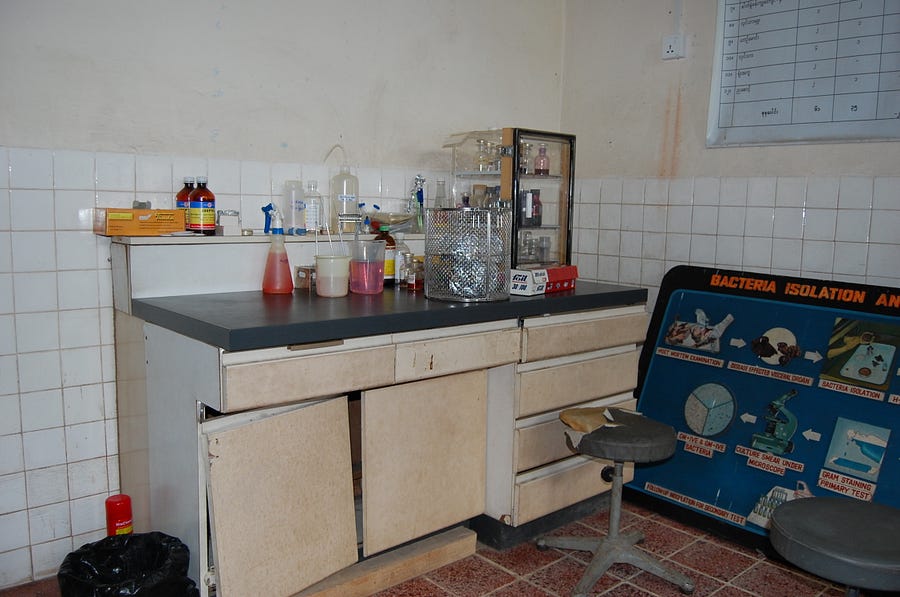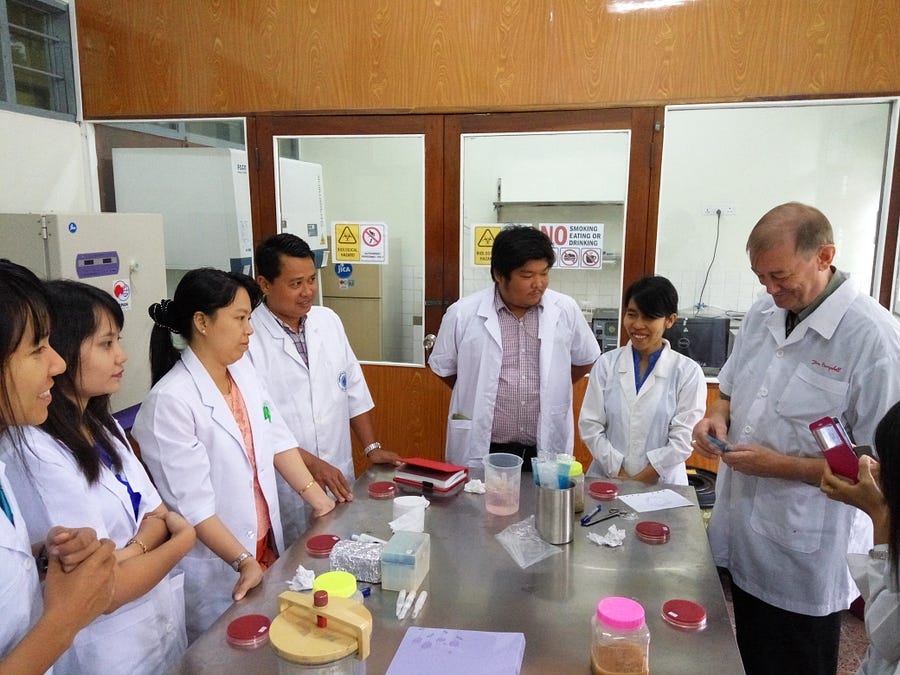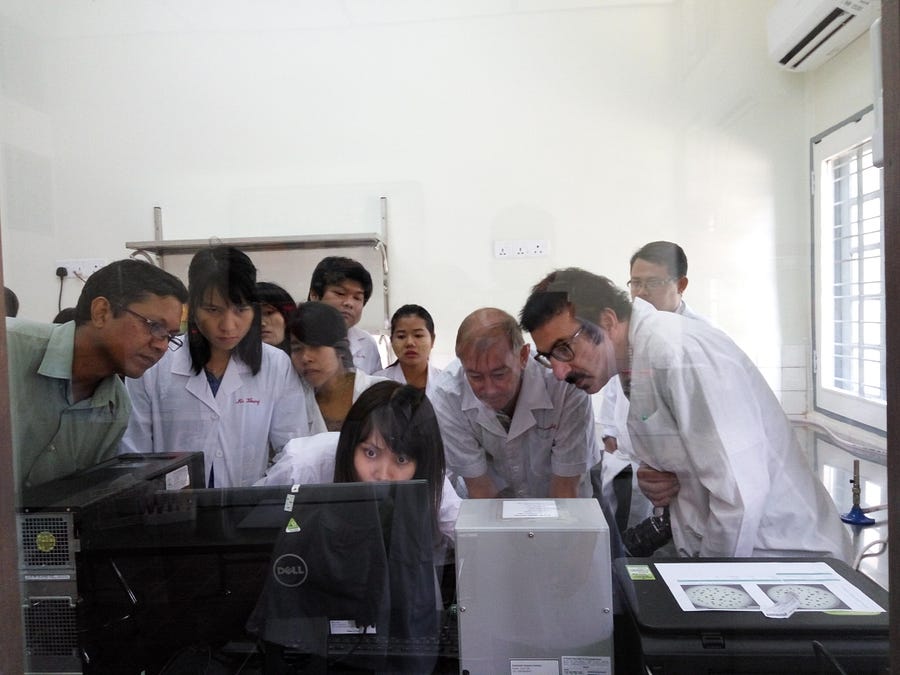An integrated management-based approach for surveillance and control of zoonoses in emerging livestock systems: Myanmar Pig Partnership

Increasing consumption of meat in developing countries, especially in South East Asia, is leading to new demands on pig and poultry supply chains and emergence of new production networks. These emerging livestock systems (ELS) are linked to peoples' changing food consumption habits, economic status, aspirations and population shifts, and to political contexts. The zoonotic threats posed by these changes are largely unknown.
It is estimate that zoonotic gastrointestinal disease, caused by bacteria such as Salmonella and Campylobacter and related antibiotic resistance, accounts for around 1 million human deaths per year globally with around 800 million people being affected, most of them children under five; a situation also reflected in the study countries Vietnam and Myanmar which rank in the top 5 hotspots for rapidity and diversity of their ELS (ILRI report to DfID).
The Myanmar Pig Partnership project, led by Dr Dan Tucker and prof Duncan Maskell, aims to exploit interdisciplinary expertise including social, biological, and governmental players from Myanmar, Viet Nam and UK to bring about step changes in pro-poor control measures using knowledge-driven and culturally relevant strategies that concomitantly improve animal health and productivity and thus improve and protect human health.
Keeping pigs and people healthy in Myanmar
Published online by STEPS in 2017.
How a research programme with capacity-building at its heart is helping efforts to shed light on livestock disease and antimicrobial resistance in the world’s fastest-growing pig producing country.
In a laboratory in steamy corner of a compound in the northern outskirts of Yangon, the workload for a team of technicians and microbiologists has more than doubled over the past year. But while the number of biological samples processed in this lab has multiplied, the time taken to undertake the work has eased — and the results obtained are now many times more accurate.
Until recently, the ageing and limited facilities at Myanmar’s Livestock Breeding and Veterinary Department (LBVD) Veterinary Diagnostic Laboratory meant that the capacity for testing livestock samples from farms and abattoirs for signs of disease was limited and time-consuming. Staff worked hard to deliver a good service, but with limited facilities it was an uphill struggle. New equipment is now speeding processes along and enabling both a new efficiency and new confidence in results.
This is big news in a country in which livestock, and pigs in particular, are an essential and increasingly important part of many people’s livelihoods — and in which diseases transmitted by pigs and pig meat are thought to be on the increase.
A valued source of income and social status
Although reliable numbers are hard to come by, in the five years to 2014 the pig population in Myanmar is thought to have increased by nearly 80%, and the country is expected to show the world’s fastest growth in pig production over the next decade or more.
Many rural households, as well as those on the edges of towns, keep pigs. The animals are a valued source of income, as well as food, social status and manure for fertiliser

A pig farmer and one of his sows in Yangon region.
The health of pigs is therefore critical to people’s health and wellbeing.
But what happens when a pig gets ill in Myanmar?
In developed countries, it is usual for owners of a sick pig to send for the vet and have a specimen of blood, faeces or saliva sent to a lab for analysis. Within days — sometimes hours — there can be a diagnosis. Treatment options or other courses of action can then be determined. But for a pig owner in Myanmar, often no such option exists.
Myanmar is coming out of years of isolation and many people live on or near the poverty line. Though the pig population is thought to be nearly 14 million, in 2014 there were only 1,240 official vets and 401 vet assistants — all carrying a heavy administrative burden. Pig owners have traditionally relied on the help of trained Community Animal Health Workers but some follow the advice of neighbours or people known locally for their expertise. Traditional preventive measures such as the use of lime powder as a disinfectant are popular.
Farmers also often turn to antibiotics, which can be bought over-the-counter from local stores. This though is not always an appropriate treatment and the guidance of vets is not always obtained.
The loss of a pig, or its reduced productivity, through misdiagnosed disease or poor or inappropriate treatment, can devastate a family’s livelihood. Some pig diseases can also be passed to people. Those most at risk of this zoonotic transmission of disease are pig farmers and frontline workers and their families, but the impacts of pig disease are thought to be widespread as risks come from eating pig meat as well as close contact with the animals. Inappropriate use of antibiotics can also select for antimicrobial resistance(AMR) in the bacteria being carried by the animal — a growing problem worldwide.
One Health
The Myanmar Pig Partnership is a multidisciplinary One Health research project exploring the risk of disease from pigs in Myanmar as the country’s livestock sector experiences growth and intensification.
Dr Dan Tucker, leading the Partnership, says: “Pigs in Myanmar are part of the fabric of village life. They live closely with humans, acting as waste food disposal — or, more correctly, recycling units. As a Buddhist country, families treat their pigs with huge respect and become very attached to them, handling them a lot. This has interesting implications for disease transmission.”
Fundamental to achieving the project’s research objectives is raising Myanmar’s laboratory capacity. This, it transpired, was no easy task.
Before refurbishment.
Although Myanmar has expertise in microbiology, the bacteriology section of LBVD’s Yangon Veterinary Diagnostic Laboratory — one of the two main veterinary labs in Myanmar — had not been updated since the 1970s, and the work required was extensive. Refurbishing and re-equipping it took months as lengthy tendering and customs processes were essential prerequisites.
Undertaking the refurbishment.
Once work could start, the facilities were rebuilt with new partitions, shelves and lab benches. They were completely rewired and repainted, and air conditioning and internet connections were installed.
Sample processing room after the refurbishment.
Seventeen different types of European-quality equipment were shipped from Vietnam, including lab-quality freezers and fridges, an autoclave for sterilising equipment, a stomacher to extract micro-organisms from meat samples, an automatic colony counter to accurately estimate a liquid culture’s density of micro-organisms, water purifiers, freeze driers and auto-centrifuges.
The LBVD lab now comprises culture and media preparation rooms meeting international standards, as well as an office and a storage room. It is equipped to provide wet microbiology support services, bacterial isolation and identification, antibiotic sensitivity testing, genomic DNA preparation, and other microbiological and serological tests. These will support the Myanmar Pig Partnership’s research and, importantly, will also provide long-term regional diagnostic capacity and ongoing support for disease and AMR surveillance in Myanmar.
While previously up to 150 biological samples a month were processed by the Yangon laboratory, up to 335 are now being processed every month. Some 135 of these come from the Partnership’s research with up to 200 received from veterinarians across the Yangon Region and beyond. The demand for these services is likely to grow as its enhanced capacity becomes more widely known.
Ensuring sustainable expertise
Equipment on its own only goes so far in the battle to keep livestock disease and antimicrobial resistance risks at bay.
Yangon lab staff are trained in how to use new equipment.
A programme of training activities for lab staff is ensuring there is sustainable expertise to keep the lab functioning effectively after the project ends in 2020. This is being provided through general and advanced on-site training sessions, for example in preparation of media, isolation and identification of Salmonella spp, E coli and Streptococcus suis from clinical specimens. The longer-term plan is that the lab will provide a source of training for other laboratories to lead a reinvigorated regional diagnostic and surveillance network. Already an opportunity for partnering with the Huazhong Agricultural University diagnostic laboratory in China has been identified.
Training in the laboratory.
This lab training has complemented other training being undertaken as part of the Partnership project, in particular that of veterinary officers, for example in obtaining samples from live pigs on farms and carcasses at abattoirs, and awareness of bacterial diseases in livestock. There has also been vet training in approaches for optimising pig health and productivity, methods for routine herd health evaluation and ways to advise pig farmers on improved productivity.
Training on farms.
Dan Tucker says: “Currently, disease outbreaks can have major impacts — often a farmer can lose a whole litter of piglets; and it might be their only litter. There are huge opportunities to make relatively small but hugely meaningful changes in animal management practices. Our training approach includes focus on neonatal piglet management, for example ensuring the litter all gets an early and adequate suck of the sow’s life-saving colostrum. Just one more piglet surviving from each litter is a major increase in profits which at family level could determine the ability to access medical care, or not.”
The long-term goal of the project is to gain a better understanding of the bacterial hazards of pig meat production in an emerging economy such as Myanmar’s. Uniquely, the project aims to combine this information with a deeper understanding of the human factors surrounding this same chain of supply, ultimately allowing the design of relevant training that leads to a safer, healthier, more productive and profitable industry.
Dan Tucker adds: “The challenge is to mesh data from our social science and veterinary science surveys to identify the best and most achievable training objectives. I’ve realised the importance of understanding people’s behaviour and especially what stops them changing, before designing the biological research. That’s very different to a traditional veterinary approach of going in saying ‘I’m important and I can see immediately what needs to be done here’.
“There’s huge benefit to be had from a genuine mutual recognition and respect for experience, skills and cultures.”
The Myanmar Pig Partnership comprises the University of Cambridge, the Myanmar Livestock Breeding and Veterinary Department, the University of Oxford Clinical Research Unit, Vietnam, and the ESRC STEPS Centre. It is funded by the Zoonoses and Emerging Livestock Systems (ZELS) programmme.
Key Publications
1. Genomic signatures of human and animal disease in the zoonotic pathogen Streptococcus suis. Weinert LA, Chaudhuri RR, Wang J, Peters SE, Corander J, Jombart T, Baig A, Howell KJ, Vehkala M, Välimäki N, Harris D, Chieu TT, Van Vinh Chau N, Campbell J, Schultsz C, Parkhill J, Bentley SD, Langford PR, Rycroft AN, Wren BW, Farrar J, Baker S, Hoa NT, Holden MT, Tucker AW, Maskell DJ Nat Commun. 2015 Mar 31;6:6740. doi: 10.1038/ncomms7740.
2. Capturing the cloud of diversity reveals complexity and heterogeneity of MRSA carriage, infection and transmission. Paterson GK, Harrison EM, Murray GG, Welch JJ, Warland JH, Holden MT, Morgan FJ, Ba X, Koop G, Harris SR, Maskell DJ, Peacock SJ, Herrtage ME, Parkhill J, Holmes MA. Nat Commun. 2015 Mar 27;6:6560. doi: 10.1038/ncomms7560.
3. Patterns of genome evolution that have accompanied host adaptation in Salmonella. Langridge GC, Fookes M, Connor TR, Feltwell T, Feasey N, Parsons BN, Seth-Smith HM, Barquist L, Stedman A, Humphrey T, Wigley P, Peters SE, Maskell DJ, Corander J, Chabalgoity JA, Barrow P, Parkhill J, Dougan G, Thomson NR. Proc Natl Acad Sci U S A. 2015 Jan 20;112(3):863-8. doi: 10.1073/pnas.1416707112. Epub 2014 Dec 22.
4. Distinguishable epidemics of multidrug-resistant Salmonella Typhimurium DT104 in different hosts. Mather AE, Reid SW, Maskell DJ, Parkhill J, Fookes MC, Harris SR, Brown DJ, Coia JE, Mulvey MR, Gilmour MW, Petrovska L, de Pinna E, Kuroda M, Akiba M, Izumiya H, Connor TR, Suchard MA, Lemey P, Mellor DJ, Haydon DT, Thomson NR. Science. 2013 Sep 27;341(6153):1514-7. doi: 10.1126/science.1240578. Epub 2013 Sep 12.
5. Comprehensive assignment of roles for Salmonella typhimurium genes in intestinal colonization of food-producing animals. Chaudhuri RR, Morgan E, Peters SE, Pleasance SJ, Hudson DL, Davies HM, Wang J, van Diemen PM, Buckley AM, Bowen AJ, Pullinger GD, Turner DJ, Langridge GC, Turner AK, Parkhill J, Charles IG, Maskell DJ, Stevens MP. PLoS Genet. 2013 Apr;9(4):e1003456. doi: 10.1371/journal.pgen.1003456. Epub 2013 Apr 18.

